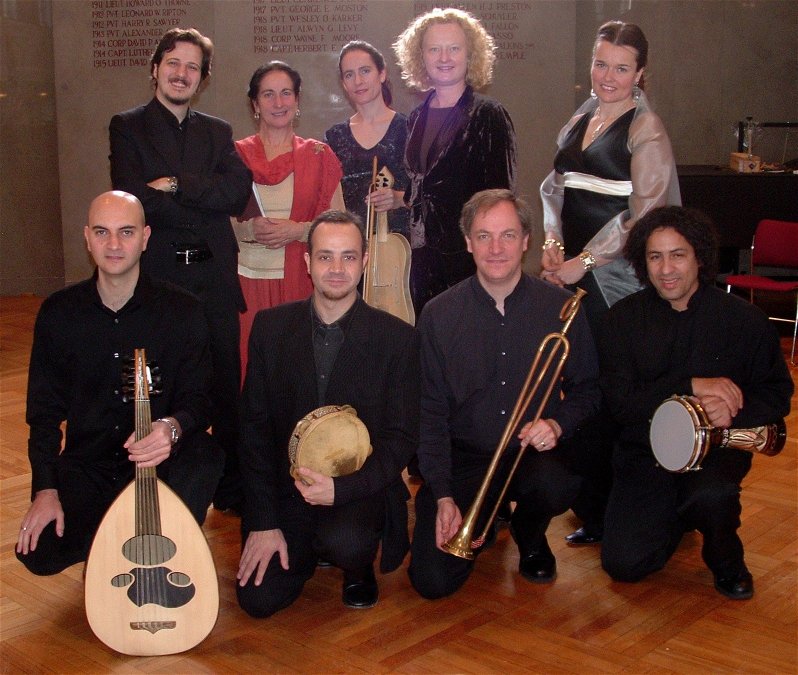Boston Camerata opens in lively fashion with Spanish music from the New World
Over the past several decades, the Boston Camerata has delved into little-heard sacred, secular, and folk music from cultures and time periods as diverse as the Middle East, medieval France, and eighteenth-century North America.
Sunday afternoon at Boston’s Trinity Church, the ensemble, led by Anne Azéma, turned to the music of colonial Central and South America in their season-opening program entitled “Nueva España: Close Encounters in the New World.”
The stories that came out of the sixteenth and seventeenth centuries, the high point of Spanish colonial power in the New World, involve much more than the heroic tales of adventurous conquistadors often encountered in school history class. Rather, the narrative tells of a tragic and bloody time when Spanish treatment of native peoples was frequently cruel and unforgiving.
Yet the situations weren’t always so dark, and the surviving documents of the time point to a flowering and unique musical culture.
Conceived in the early 1990s by former director Joel Cohen for a commission from the Tanglewood Festival, “Nueva España” combines sacred music from around the Spanish Empire with colonial songs that draw upon native and African rhythms.
With an ensemble that paired singers with guitars, period brass instruments, and hand-held percussion instruments of all types, Sunday’s performance of the program brought this little-heard music to new life.
Many of the works heard were written in a high-Renaissance style that was well out of fashion in continental Europe during the seventeenth century. But the New World, as Joel Cohen and Azéma commented in their program notes, was “a time warp within a time warp.”
Lamentatio by Don Juan de Lienas is one such example. Listening to its web of glowing and interlocking lines, one might place the piece in the sixteenth century, though it dates from about 1650. It is gorgeous music nonetheless, and the singers of the Boston Camerata—soprano Camila Parias, alto Deborah Rentz-Moore, tenor Daniel Hershey, baritone Vicente Chavarria, and bass Donald Wilkinson—sang with a rich tonal blend while Azéma coaxed languid lines from the ensemble.
In contrast, Hanacpachap Cussicuinin, a hymn-like work penned by Juan Pérez Bocanegra, involves sturdy blocks of chords that move glacially. The Camerata singers rendered the music with pristine sonorities while the young vocalists of the Trinity Choristers and Boston City Singers supplied additional layers of shimmering tone.
The most famous Spanish composer of this era was Tomás Luis de Victoria, who was represented Sunday with the “Agnus Dei” from his Missa Ave Regina. The Boston Camerata, joined again by the Trinity Choristers and Boston City Singers, sang a warm rendering of this moving piece. Alto Deborah Rentz-Moore and Azéma trading arching melodies, which were echoed by the full ensemble in golden sheets of sound.
Other pieces on the program combined Baroque musical styles with elements of Spanish vernacular music. The running polyphonic lines of A Este Sol Peregrino, by the Spanish-turned-Peruvian composer Tomas de Torrejón y Velasco, were spiced with guitar and castanets for streams of whirling rhythms. Lending the dance-like support to the singers were guitarist Olav Chris Henriksen and viola da gambist Carol Lewis, who played with fine sense of the music’s style.
Antonio de Salazar’s Tarara, Tarara, a song from late seventeenth-century Mexico, told of an African boy by the name of Anton who traveled to Bethlehem to see the Christ child. The piece is a stirring dance song that seemed to spin around in its place. Singers Hershey, Chavarria, and Wilkinson delivered a riveting account while Azéma punctuated the instrumental accompaniment with well-place rhythms on the tambourine.
Another Christmas tune, Los Coflades de la Estleya, by Juan de Araujo, tells a version of the Magi story where African cousins of the three kings travel to Bethlehem. Like Tarara, the piece is chock-full of zesty rhythmic twists and intricate vocal lines. The most effective ingredient in Sunday’s performance was supplied by the singers of the Haitian choir Les Fleurs des Caraîbes, who supported the song’s florid melodies with aptly throaty tones for a beautiful and penetrating sound.
The program also featured colorful pieces for instruments. The brass ensemble, which consisted of sackbuts and cornet played by Steven Lundahl, Liza Malamut, Brian McKay, and Chris Belluscio, supplied warm accompaniment to many of the vocal works. To open the program, the ensemble played a solid and colorful Cum Audisset Johannes, a short piece by Alonso Lobo. Cumba featured equally fine playing from the string trio, played by Chavarria (guitar), Henriksen (guitar) and Lewis (viola da gamba), who rendered the piece’s side-winding rhythms, sharp strums, and intricate passagework with aplomb.
Instrumentalists and vocalists all came together for a rousing closer, a guaracha entitled Convidando Esta la Noche by Juan Garcia de Zéspiedes. This work is a rippling, mixed-meter dance tune, replete with energetic singing, syncopated guitar strums, and percussive rhythms of all sorts.
The music brought the audience to its feet, and the Camerata and company offered a refrain of the piece as an encore, sending listeners into the afternoon with a spring in their step.
Boston Camerata will perform a Mediterranean Christmas program December 18-21 in Lexington, Newberry, and Cambridge. bostoncamerata.com
Posted in Performances





